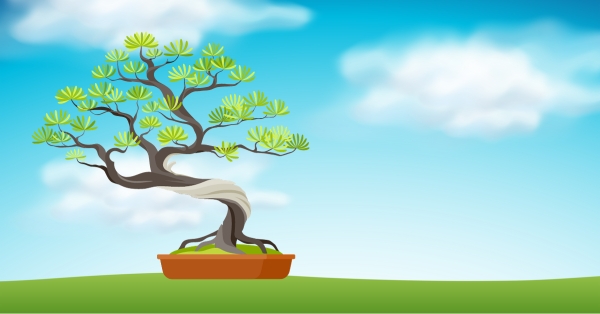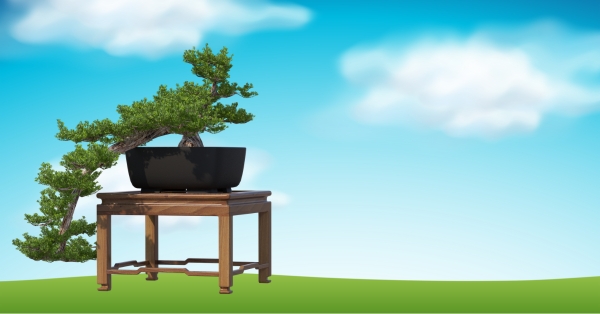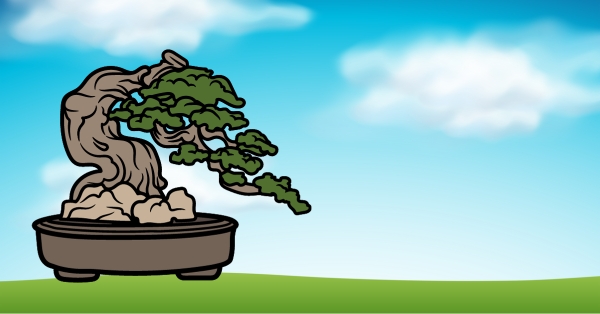Bonsai is the art of cultivating miniature trees. The art has captured the interest of plant enthusiasts for centuries. These tiny majestic wonders are beautiful creations that emerge when humans sync with Mother Nature. The cultivation of a Bonsai plant showcases virtues like patience, dedication, and a deep understanding of horticulture. They are perfect for garden enthusiasts looking to create miniature gardens.
.
The History of Bonsai
Bonsai plants date back over a thousand years to ancient China, where it was known as ‘penjing’. However, it was in Japan that the art of making Bonsai trees flourished. The Japanese refined the techniques, aesthetics, and philosophy and transformed it into what we know about Bonsai today. Bonsai means ‘tray planting’, in Japan and has become an integral part of the country’s culture. They symbolize harmony, balance, and connection with nature.
.
Types of Bonsai
.
Formal Upright (Chokkan)

The formal upright bonsai style is characterized by a straight, upright trunk with gradually decreasing branch size as you move up the tree. This style conveys a sense of strength and stability.
.
Informal Upright (Moyogi)

Moyogi bonsai features a slightly curved or sinuous trunk. This offers a more natural and relaxed appearance. The branches may vary in size and direction.
.
Slanting (Shakan)

In the slanting style, the tree's trunk leans to one side while maintaining a sense of balance. This style often evokes the image of a tree growing against the wind.
.
Cascade (Kengai)

Cascade bonsai imitate trees growing over cliffs or waterfalls, with their branches and foliage cascading downward. This style creates a dramatic and dynamic visual.
.
Semi-Cascade (Han-Kengai)

Similar to the cascade style, semi-cascade bonsai have a slanted trunk, but the branches do not cascade as dramatically. This style offers a more subtle and balanced appearance.
.
Literati (Bunjin)

Literati bonsai are characterized by their twisted and contorted trunks, giving them a windswept and artistic appearance. This style often conveys a sense of age and character.
.
Windswept (Fukinagashi)

The windswept style mimics trees shaped by strong winds, with branches and foliage swept to one side. It imparts a sense of resilience and endurance.
.
Broom (Hokidachi)

Broom bonsai have a straight, upright trunk with symmetrical branches arranged in a broom-like fashion. This style is clean, balanced, and formal.
.
Group Planting (Yose-ue)

Group planting bonsai consists of multiple trees planted together in a harmonious arrangement, resembling a miniature forest. This style emphasizes the beauty of natural groupings.
.
Bonsai Care Tips
Light:
Bonsai trees require adequate sunlight. Place them in a location with bright, indirect sunlight for most species. Some may benefit from a few hours of morning sun.
Watering:
Bonsai trees need consistent moisture, but overwatering can be detrimental. Water when the topsoil feels slightly dry, and ensure good drainage to prevent root rot.
Pruning and Trimming:
Regular pruning and trimming are essential to maintain the desired shape and size of your bonsai. Use specialized bonsai shears for precise cuts.
Fertilization:
Bonsai trees have specific nutrient requirements. Use a balanced, slow-release fertilizer during the growing season and reduce fertilization during the dormant period.
Repotting:
Repot your bonsai every 2-5 years, depending on the tree's age and growth rate. This promotes root health and provides fresh soil.
Wiring:
Wiring is a technique used to shape the branches and trunk of a bonsai. Be careful not to damage the tree, and remove the wire when it starts to bite into the bark.
.
Pest and Disease Control
Keep a watchful eye on pests and diseases. Common issues include aphids, scale insects, and fungal infections. Address these problems promptly. You can also use pesticides.
.
Winter Care
Protect your bonsai from freezing temperatures. Some species require winter dormancy, while others may need to be kept indoors during the cold months.
.
The Meditative Qualities of Bonsai
Beyond their physical beauty, bonsai plants offer numerous psychological and meditative benefits. The art of bonsai demands patience, attention to detail, and a deep connection with nature. Here's how cultivating bonsai can be a meditative practice:
Mindfulness
Bonsai requires a gentle and focused approach. Caring for your bonsai forces you to be present in the moment, allowing you to practice mindfulness and reduce stress.
Patience
Bonsai trees grow slowly, and shaping them takes time. This teaches patience and the value of gradual progress.
Creativity
Bonsai artists have the creative freedom to shape and design their miniature trees. This creativity provides an outlet for self-expression.
Connection with Nature
Bonsai enthusiasts often develop a profound connection with their trees. The act of nurturing a living being deepens one's appreciation for the natural world.
Stress Relief
Tending to bonsai can be a therapeutic escape from the stresses of daily life. The act of caring for a bonsai tree can be deeply relaxing.
Conclusion
Bonsai plants are more than just potted trees; they are living art forms that encompass history, culture, and a unique connection with nature. By understanding the various bonsai styles, practicing proper care techniques, and appreciating their meditative qualities, you can embark on a fulfilling journey into the world of bonsai. Whether you're a seasoned bonsai enthusiast or a beginner, the world of bonsai offers endless possibilities for creativity, growth, and inner peace. So, go ahead and nurture your own tiny forest, and let the beauty of bonsai enrich your life.


